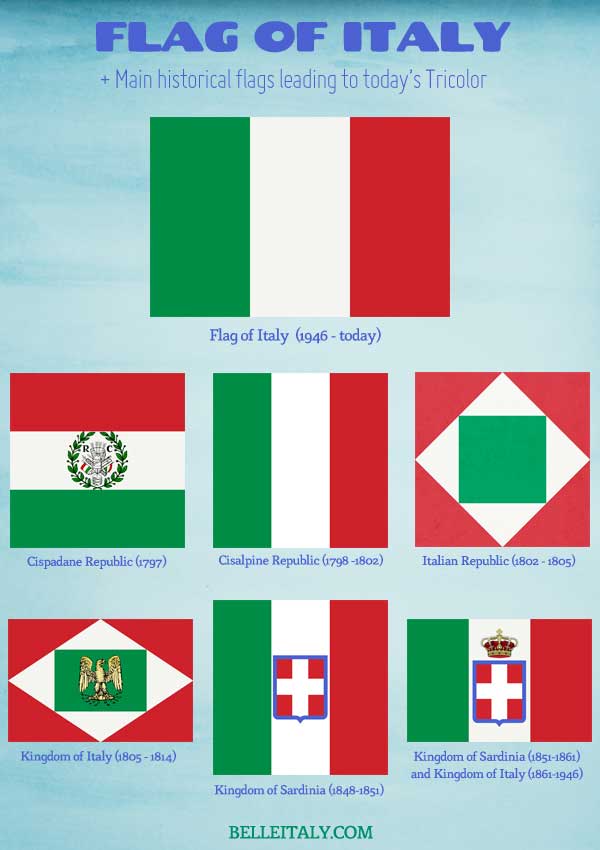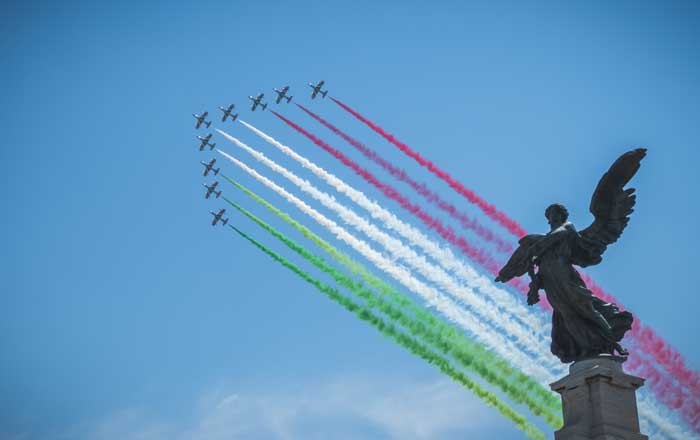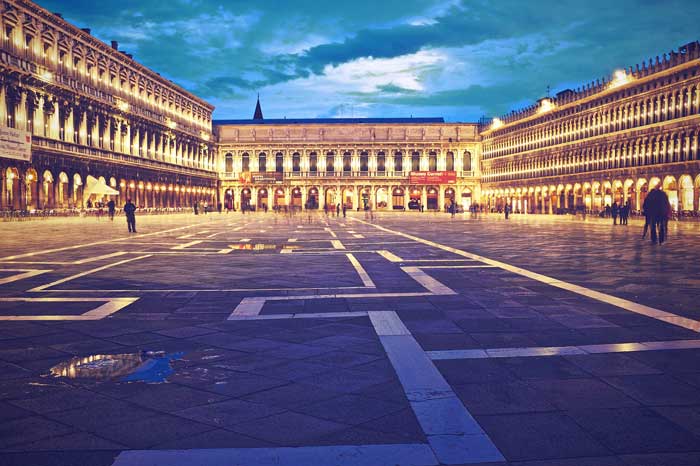Today’s Italian Flag and Historical Tricolors

The Italian flag, il Tricolore (tricolor) as it is often referred to in Italian, is the national flag of the Italian Republic in use since 1946 and officially since December 1947. In 1997, on the second centenary of the Italian tricolor, the 7th of January was declared the National Day of the Flag —Festa del Tricolore.
The Italian Flag Day shouldn’t be mistaken for the Festa della Repubblica, the Italian National Day celebrated each 2nd of June.
What Color Is The Italian Flag?
The colors of the flag of Italy are green, white, and red.
The Italian flag is a tricolor flag featuring three vertical bands of equal size in green, white and red, with the green at the hoist side.

Fluttering Flag of Italy
Italian Flag Meaning
Like other national flags across the world such as Mexico’s, the Italian flag is rooted in the French flag used by French revolutionaries from 1790.
In Italy the blue of the French flag was replaced with green, a color used in the first Italian tricolor cockades (rosettes and ribbons) that symbolized the natural rights, the ideals of equality and freedom.
In the 19th-century the meaning of the three colors of the Italian Tricolor became more idealistic. Writers, poets, and scholars saw the meaning of the colors of the Italian flag in a poetic light. The green stood for hope, the hope for a free and united Italy, the white for faith and the red for charity and love.
In the speech “Il Tricolore” made on January 7, 1897, to commemorate the first centenary of the formal adoption of the tricolor Italian flag, the national poet Giosuè Carducci passionately talked about the meaning of the Italian flag colors:
For Carducci white was the faith in the ideas that animate the sages; green, the hope that regenerates in nature; red, the passion and the blood of the martyrs and heroes who gave their lives for the country.
“[…] Not rampant eagles and lions, not overpowering wild beasts in the holy banner; but the colors of our spring and our land, from Cenisio to Etna; the snows of the Alps, April in the valleys, the flames of the volcanoes. […]”
Giosuè Carducci

Italian National Day Celebrations in Rome
Origins of the Italian Flag
Shortly after the French revolutionary events, the ideals of social innovation began to spread widely in Italy, thus the blue, white and red colors of the French flag became the first reference of the Italian Jacobins and later a source of inspiration for the creation of an Italian identity banner.
The Italian papers of the time wrongly reported that the French tricolor was green, white and red, and for a while Italians believed that those were the colors of the French flag and used them as a way to show their support of the revolutionary ideals.
The very first use of the Italian tricolor cockade is dated 21 August 1789. As documented in the historical archives of the Republic of Genoa, some eyewitness reported that protesters were wandering around the city with a tricolor cockade pinned on their clothing.
Although not all historians agree, the green, white and red on a tricolor cockade reappeared on November 1794 during the failed uprising in Bologna against the Papal State led by Luigi Zamboni and Giovanni Battista De Rolandis.
However, scholars do agree that the circular Italian cockade with the national colors of Italy —green, white and red— first appeared in Milan in 1796.
The Tortuous Italian Flag History
The first official documents trace the use of the green, white and red flag to the first Italian campaign of Napoleon, (1796-1797) fought with the contribution of numerous Italian Jacobins.

Flag of the Cispadane Republic (1797)
Cispadane Republic (1797) – Although the Italian tricolor had been previously used as a military banner and a civic symbol of local authorities, the history of the flag of Italy officially begins on the 7th of January, 1797 when an Italian sovereign state, the Cispadane Republic, adopted it as a national flag for the first time.
This significant event was held in the Palazzo del Comune of Reggio nell’Emilia, in the hall of the ducal archives, known today as Sala del Tricolore.
Next to the Tricolor Hall there is the Museum of the Tricolor, opened in January 2004. It displays documents and relics related to the Italian flag and a large number of tricolor flags of the Italian pre-unification states

Flag of the Cisalpine Republic (1798-1802)
Cisalpine Republic (1798-1802) – Soon later the Cispadane Republic merged into the Cisalpine Republic, a sister Republic of France in Northern Italy.
Originally the colors of the flag of the Cisalpine Republic were arranged horizontally, with the green placed at the top, but on May 11, 1798, the Republican Council made official the square-shaped vertical tricolor.
Gradually the Italian flag grew in popularity until it became one of the most important symbols of the Risorgimento. It was during this time that the Italian flag began to enter the collective imagination as a symbol of Italy

Flag of the Italian Republic (1802-1805)
Italian Republic (1802 – 1805) – In 1802 the Cisalpine Republic became the Napoleonic Italian Republic. The flag maintained the same colors but with a different, less revolutionary, arrangement —a red background carrying a green square within a white rhombus.

Flag of the Kingdom of Italy (1805-1814)
Kingdom of Italy (1805 – 1814) – On March 1805 the Italian Republic became the Kingdom of Italy ruled by Napoleon I as King of Italy. The flag of the Regno Italico was the same as the former Italian Republic’s but in a rectangular shape and with Napoleon’s eagle on the green rectangle.
Il Tricolore Becomes Subversive
With the fall of Napoleon and the Restoration of absolutist monarchical regimes, the Italian tricolor went underground, becoming a symbol of patriotism that united the struggle of Italians fighting for freedom and independence.
During the revolts of Milan of 1848, the tricolor flag of Italy clearly consolidated itself as a patriotic symbol that united all Italians fighting against foreign domination.
The Risorgimento and the Tricolore
The Risorgimento was the political and social movement that began in 1815 and culminated in the 17th of March, 1861 with the proclamation of the Kingdom of Italy that unified the different states of Italy (except for Venetia, Rome, Trento and Trieste) and adopted the tricolor as the national banner.

Flag of the Kingdom of Sardinia (1848-1851)
Kingdom of Sardinia (1848-1851) – On May 8, 1848, the tricolor flag became the official national flag of the Kingdom of Sardinia when it was put up for the first time on Palazzo Madama in Turin.
In a speech delivered before the Parliament of the Kingdom of Sardinia on 9 June 1848, King Charles Albert declared that “The tricolor flag was and will be blessed by God […]”

Flag of the Kingdom of Sardinia (1851-1861)
Kingdom of Sardinia (1851-1861) – This flag of the Kingdom of Sardinia with the royal crown above the shield of the House of Savoy later became the banner of the Kingdom of Italy.

Flag of the Kingdom of Italy (1861-1946)
Kingdom of Italy (1861-1946) – The tricolor continued to be the national flag of the Kingdom of Italy proclaimed on March 17, 1861.
The new Kingdom of Italy was ruled by Victor Emmanuel II, the first king of a united Italy since the 6th century. The Altar of the Fatherland in Rome, also known as Il Vittoriano, was built in his honor.

Flag of the Italian Republic (1956 – today)
Italian Repubblic (from 1946) – With the birth of the Italian Republic in June 1946 the Savoy coat of arms disappeared from the Italian flag.
Article 12 of the Constitution of the Italian Republic reads: The flag of the Republic is the Italian tricolor: green, white and red, with three vertical bands of equal size.”





